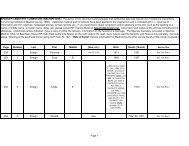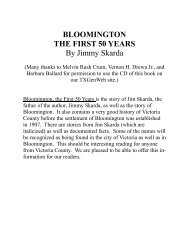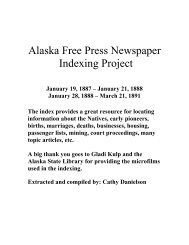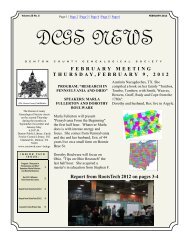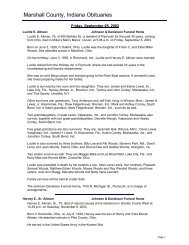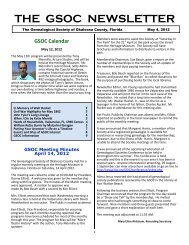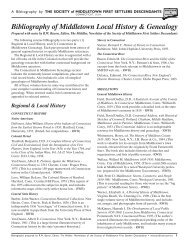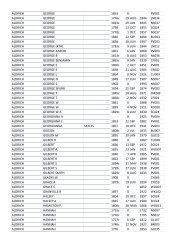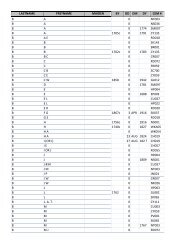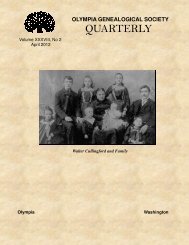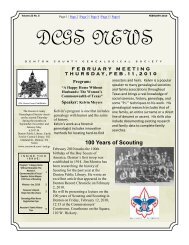Indian population in the United States and Alaska. 1910 - RootsWeb
Indian population in the United States and Alaska. 1910 - RootsWeb
Indian population in the United States and Alaska. 1910 - RootsWeb
Create successful ePaper yourself
Turn your PDF publications into a flip-book with our unique Google optimized e-Paper software.
STOCKS AND TRIBES, BY SEX, AGE. AND MIXTURE OF BLOOD.<br />
In <strong>the</strong> census of <strong>1910</strong> <strong>the</strong> attempt was made to<br />
enumerate <strong>Indian</strong>s by tribes, <strong>and</strong> to secure data as<br />
well <strong>in</strong> regard to <strong>the</strong> tribal affiliations of both parents.<br />
The rapid changes tak<strong>in</strong>g place ia <strong>the</strong> conditions of<br />
<strong>Indian</strong> life are break<strong>in</strong>g down <strong>the</strong> tribal organization,<br />
<strong>and</strong> it was felt that this was perhaps <strong>the</strong> last oppor-<br />
timity to secure <strong>in</strong>formation which should be reasona-<br />
bly rehable upon <strong>the</strong>se po<strong>in</strong>ts. Unfortunately, <strong>the</strong><br />
data desired were not secured for those <strong>Indian</strong>s who<br />
were li\Tng widely scattered among <strong>the</strong> general popu-<br />
lation, <strong>and</strong> who to <strong>the</strong> number of 18,546 were enumerated<br />
only on <strong>the</strong> general <strong>population</strong> schedule, no<br />
special schedules be<strong>in</strong>g obta<strong>in</strong>ed for <strong>the</strong>m. The num-<br />
bers enumerated of <strong>the</strong> different tribes are, <strong>the</strong>refore,<br />
too small <strong>in</strong> vary<strong>in</strong>g degree, as some persons who<br />
should have been coim.ted as members of particular<br />
tribes were <strong>in</strong>stead enumerated simply as "<strong>Indian</strong>s"<br />
on <strong>the</strong> general <strong>population</strong> schedule. The extent of<br />
this understatement varies considerably <strong>in</strong> different<br />
states, but <strong>the</strong> actual error is beheved to be compara-<br />
tively small <strong>in</strong> most cases.<br />
The determ<strong>in</strong>ation of tribal affLliation <strong>in</strong> <strong>the</strong> case of<br />
<strong>Indian</strong>s of mixed-tribal blood presented someth<strong>in</strong>g of<br />
a dilenuna, <strong>in</strong>asmuch as affiliation might be counted<br />
ei<strong>the</strong>r by <strong>in</strong>heritance or by blood. In <strong>the</strong> former<br />
case <strong>the</strong> tribe to which an <strong>in</strong>dividual belonged would<br />
depend on <strong>the</strong> particular system of <strong>in</strong>heritance (that<br />
is, maternal or paternal) which was followed. If <strong>the</strong><br />
tribe among which he hved followed <strong>the</strong> former sys-<br />
tem, he wotdd be affiihated with <strong>the</strong> mo<strong>the</strong>r's tribe; if<br />
<strong>the</strong> latter, with that of <strong>the</strong> fa<strong>the</strong>r. As different tribes<br />
employ different methods this threatened to <strong>in</strong>volve<br />
serious confusion. To take an extreme example:<br />
If <strong>the</strong> fa<strong>the</strong>r <strong>and</strong> mo<strong>the</strong>r of an <strong>Indian</strong> were each re-<br />
ported as of mixed-tribal blood, to which of <strong>the</strong> four<br />
tribes represented <strong>in</strong> <strong>the</strong> <strong>in</strong>dividual should he be at-<br />
tributed ? On <strong>the</strong> o<strong>the</strong>r h<strong>and</strong>, as <strong>the</strong> primary basis of<br />
classification of <strong>Indian</strong>s was purity of blood, it would<br />
be logical to make tribal affiliation also dependent<br />
on actual descent, although this might, <strong>in</strong> some cases,<br />
lead to <strong>the</strong> coimt<strong>in</strong>g of an <strong>in</strong>dividual as a member<br />
of a tribe o<strong>the</strong>r than that to which he claimed to<br />
belong. After careful consideration <strong>and</strong> trial it was<br />
determ<strong>in</strong>ed that <strong>the</strong> latter method presented fewer<br />
difficulties <strong>and</strong> chances of error, <strong>and</strong> consequently an<br />
arbitrary rule was adopted of count<strong>in</strong>g <strong>Indian</strong>s of<br />
mixed-tribal blood as members always of <strong>the</strong> fa<strong>the</strong>r's<br />
tribe. The only exceptions to this rule were <strong>in</strong> cases<br />
where, ow<strong>in</strong>g to complexity of blood <strong>in</strong> both parents,<br />
<strong>the</strong> rule would lead to obviously <strong>in</strong>correct results. In<br />
such cases tribal affiliation was held to follow <strong>the</strong> dom<strong>in</strong>ant<br />
blood, if any; o<strong>the</strong>rwise, that of <strong>the</strong> fa<strong>the</strong>r's<br />
fa<strong>the</strong>r. In short, actual blood relationship was fol-<br />
INTRODUCTION.<br />
lowed as far as possible <strong>in</strong> determ<strong>in</strong><strong>in</strong>g <strong>the</strong> tribe to<br />
which an <strong>in</strong>dividual belonged. The differences between<br />
<strong>the</strong> numbers obta<strong>in</strong>ed for <strong>in</strong>dividual tribes by<br />
<strong>the</strong> use of this method as opposed to that of customary<br />
<strong>in</strong>heritance are not beheved to be considerable. Close<br />
observation of several cases showed httle change, <strong>and</strong><br />
<strong>the</strong> certa<strong>in</strong>ty of this mode of treatment as opposed<br />
to <strong>the</strong> uncerta<strong>in</strong>ty <strong>and</strong> confusion which were found to<br />
arise <strong>in</strong> follow<strong>in</strong>g <strong>the</strong> o<strong>the</strong>r method is beheved to<br />
justify it.<br />
Table 50 (p. 116) gives <strong>in</strong> summarized form, for each<br />
stock <strong>and</strong> tribe <strong>in</strong> <strong>the</strong> <strong>United</strong> <strong>States</strong> <strong>and</strong> <strong>Alaska</strong>, a<br />
statement of <strong>the</strong> number of <strong>Indian</strong>s reported <strong>in</strong> <strong>1910</strong>,<br />
classified accord<strong>in</strong>g to purity of blood <strong>and</strong> sex. A<br />
detailed distribution accord<strong>in</strong>g to purity of blood, tribal<br />
mixture, sex, <strong>and</strong> age is given for each stock <strong>and</strong><br />
tribe <strong>in</strong> <strong>the</strong> <strong>United</strong> <strong>States</strong> <strong>in</strong> Table 51 (p. 123), while a<br />
similar distribution accord<strong>in</strong>g to purity of blood, sex,<br />
aijd age is given for each stock <strong>and</strong> tribe <strong>in</strong> <strong>Alaska</strong> <strong>in</strong><br />
Table' 52 (p. 154) . In <strong>the</strong>se tables, as well as <strong>in</strong> <strong>the</strong> fol-<br />
low<strong>in</strong>g textual statement as to <strong>the</strong> habitat of each<br />
stock <strong>and</strong> tribe, <strong>the</strong> various tribes are, for convenience,<br />
grouped alphabetically by hnguistic stocks, <strong>the</strong> location<br />
of which may be seen by reference to <strong>the</strong> map<br />
opposite page 9.^ Any particular tribe may be readily<br />
found by reference to <strong>the</strong> alphabetical list of tribes as<br />
given <strong>in</strong> Table 9 (p. 17).<br />
A separate presentation is given for each stock <strong>in</strong> <strong>the</strong><br />
<strong>United</strong> <strong>States</strong>, both <strong>in</strong> <strong>the</strong> textual statement <strong>and</strong> <strong>in</strong><br />
Table 51 (p. 123), as follows:<br />
Algonquian.



